VSG member John Ireland, Health and Safety Advisor, Forestry and Land Scotland has been developing advice on managing risk for mountain biking.
Based on experience learned over a number of years John has teamed up with Sport Scotland to make the guidance more widely available.

The remaining content in this section is only available to VSG Members or Subscribers. So please either login (link) or subscribe (link) for 24 hour access
VSG member John Ireland, Health and Safety Advisor, Forestry and Land Scotland has been developing advice on managing risk for mountain biking.
Based on experience learned over a number of years John has teamed up with Sport Scotland to make the guidance more widely available.

The remaining content in this section is only available to VSG Members or Subscribers. So please either login (link) or subscribe (link) for 24 hour access
[block_anchor] => [block_format] => custom_subnav [block_introduction_title] => [block_custom_subnav] => [block_section_heading] => [product] => [product_text] => ) [1] => stdClass Object ( [block_count] => 1 [layout] => text_block [slug] => block-6861515a [title] => [source] => page [visibility] => 0 [background_colour] => bg-transparent [block_width] => full [width] => stdClass Object ( [container_class1] => container-fluid bg-transparent p-4 mb-4 [container_class2] => container [container_class3] => ) [class] => fcb-text_block [content] =>Templates
If you are starting from scratch, there is a complete template to lead you through all the stages of planning, design and construction.
Guide to Project Development MTB Facilities
There is advice on grading cross country trails from easy through to severe: Guide to Cross Country Trails
Downhill trails descend on steeper slopes than cross country resulting in higher speed and more extreme technical features.
This datasheet contains design characteristics for Downhill Extreme, Four Cross and Mini 4X Track: Guide to Downhill Trails
Special facilities can be created for cyclists to develop their skills and techniques: Guide to Skills Areas
Mountain bikers frequently set up their own trails. What should you do if you find something like this on your land?
Wild Trail Desire Line Management
There is a good example of the guidance being put into practice in Dalby Forest, which appears as a case study below.
Worcester County Council’s Countryside Service grappled with the issue of wild trails in Kingsford Forest Park. It was one of the earliest case studies published on our website over twelve years ago!
[block_anchor] => [block_format] => full_width [block_introduction_title] => [block_custom_subnav] => [block_section_heading] => Templates [product] => [product_text] => ) [2] => stdClass Object ( [block_count] => 2 [layout] => featured_list [slug] => block-534f7701 [title] => Case Studies [source] => page [visibility] => 0 [background_colour] => bg-transparent [block_width] => full [width] => stdClass Object ( [container_class1] => container-fluid bg-transparent p-4 mb-4 [container_class2] => container [container_class3] => ) [class] => fcb-featured_list [posts] => Array ( [0] => WP_Post Object ( [ID] => 829 [post_author] => 1 [post_date] => 2021-06-07 15:12:10 [post_date_gmt] => 2021-06-07 14:12:10 [post_content] => Dalby Forest in North York Moors is owned and managed by Forestry England It is an excellent example of how leisure activities can be safely accommodated within a working forest. The forest contains over 8,000 acres of woodland that is open for exploration by the public. Facilities include play areas for children, barbecue sites, waymarked trails, cafés, cycle hire, craft workshops and a visitor centre, opened in 2007. This case study illustrates two of the fundamental guiding principles of the Visitor Safety Group.- take account of conservation, heritage, recreation, cultural and landscape objectives
- do not take away people’s sense of freedom and adventure
 Dalby Forest Visitor Centre
The visitor centre, being easily accessible by car and with its facilities for children, sits firmly at the “urban environment” end of the spectrum. There is a high level of management intervention to ensure visitors are safe.
Dalby Forest Visitor Centre
The visitor centre, being easily accessible by car and with its facilities for children, sits firmly at the “urban environment” end of the spectrum. There is a high level of management intervention to ensure visitors are safe.
 Cycling
Challenging cycling provision illustrates the opposite end of the risk control matrix. The black routes require users to take responsibility for their own safety with a very high level of technical ability and fitness expected. Routes are graded and clearly signed so that cyclists do not inadvertently take on terrain that is beyond their capabilities.
A green route is included that does not require special skills or fitness, designed for beginners and families.
There are 73 kilometres of graded and sign-posted routes and a specially designed skills area, Dixon’s Hollow, making Dalby Forest one of the best purpose-built facilities for cycling in the country.
The skills area has been created in 3 acres of old quarry. This helps to screen it from view and restrict access. It is, however, close to a car park and forest road, which allows easy ambulance access. It is also possible to land a helicopter nearby. Forestry England staff carry out a daily visual inspection and make a written weekly report on site safety.
Care is taken to ensure that here are no nasty surprises. Signs at Dixon’s Hollow clearly warn riders of the risks, and indicate the level of skill expected. The design of the skills area incorporates carefully positioned rocks that require appropriate levels of skill to access the track. Heights are kept under 1 metre to minimise the severity of injuries from falls.
This was all designed by Forestry England in partnership with Pace Cycles and the SingletrAction user group.
SingletrAction is affiliated to the International Mountain Biking Association (IMBA) and work using their standards. These aim to ensure sustainable, natural trails that cause minimum disturbance to the landscape and give maximum fun on the bike.
Forestry England brought forward plans for forestry work along the lines of the trails. In effect, the next 10 years of anticipated work on the trees was carried out prior to the construction of the cycle routes. This should ensure that future use will not be disrupted for some time.
Go Ape
The forest caters for adventurous visitors with ‘Go Ape!,’ a high wire challenge course of rope bridges, tarzan swings, and zip slides, 40 feet up in the trees.
Go Ape! operate a dozen sites and have worked on Forestry England land since 2002. Their vision is to provide an eco-educational experience where participants absorb valuable risk assessment and risk management skills, whilst having a naturally thrilling time on an environmentally responsible and sustainable activity.
The challenge course is designed in association with conservationists and arboriculturists to ensure that the structures are safe. These specialists use their knowledge and experience, together with techniques such as ultrasound to monitor the internal health of the trees, to ensure that the natural environment is protected. The structures are designed to allow trees to grow unrestricted. Build materials are selected to blend into the natural scenery.
An element of risk is designed into the activity. This follows the Go Ape! philosophy that exposure to risk in reasonably controlled circumstances is necessary for people to learn how to safely assess and deal with risks that present themselves in life.
Everyone receives a safety briefing from a trained instructor at the start and must wear a safety harness. But after that participants are unaccompanied and take responsibility for attaching themselves to the safety system. A similar course for young adventurers provides a similar experience but with a permanent attachment.
Visitor centre 2007
One of the ways to ensure that new leisure facilities are safe is to bring in technical expertise at the design stage. Specialists in the relevant disciplines were consulted to ensure that the retail and café areas were appropriately designed and laid out to achieve safe visitor flows.
Considerable care has been taken to minimise the impact of the centre. The design incorporates:
Cycling
Challenging cycling provision illustrates the opposite end of the risk control matrix. The black routes require users to take responsibility for their own safety with a very high level of technical ability and fitness expected. Routes are graded and clearly signed so that cyclists do not inadvertently take on terrain that is beyond their capabilities.
A green route is included that does not require special skills or fitness, designed for beginners and families.
There are 73 kilometres of graded and sign-posted routes and a specially designed skills area, Dixon’s Hollow, making Dalby Forest one of the best purpose-built facilities for cycling in the country.
The skills area has been created in 3 acres of old quarry. This helps to screen it from view and restrict access. It is, however, close to a car park and forest road, which allows easy ambulance access. It is also possible to land a helicopter nearby. Forestry England staff carry out a daily visual inspection and make a written weekly report on site safety.
Care is taken to ensure that here are no nasty surprises. Signs at Dixon’s Hollow clearly warn riders of the risks, and indicate the level of skill expected. The design of the skills area incorporates carefully positioned rocks that require appropriate levels of skill to access the track. Heights are kept under 1 metre to minimise the severity of injuries from falls.
This was all designed by Forestry England in partnership with Pace Cycles and the SingletrAction user group.
SingletrAction is affiliated to the International Mountain Biking Association (IMBA) and work using their standards. These aim to ensure sustainable, natural trails that cause minimum disturbance to the landscape and give maximum fun on the bike.
Forestry England brought forward plans for forestry work along the lines of the trails. In effect, the next 10 years of anticipated work on the trees was carried out prior to the construction of the cycle routes. This should ensure that future use will not be disrupted for some time.
Go Ape
The forest caters for adventurous visitors with ‘Go Ape!,’ a high wire challenge course of rope bridges, tarzan swings, and zip slides, 40 feet up in the trees.
Go Ape! operate a dozen sites and have worked on Forestry England land since 2002. Their vision is to provide an eco-educational experience where participants absorb valuable risk assessment and risk management skills, whilst having a naturally thrilling time on an environmentally responsible and sustainable activity.
The challenge course is designed in association with conservationists and arboriculturists to ensure that the structures are safe. These specialists use their knowledge and experience, together with techniques such as ultrasound to monitor the internal health of the trees, to ensure that the natural environment is protected. The structures are designed to allow trees to grow unrestricted. Build materials are selected to blend into the natural scenery.
An element of risk is designed into the activity. This follows the Go Ape! philosophy that exposure to risk in reasonably controlled circumstances is necessary for people to learn how to safely assess and deal with risks that present themselves in life.
Everyone receives a safety briefing from a trained instructor at the start and must wear a safety harness. But after that participants are unaccompanied and take responsibility for attaching themselves to the safety system. A similar course for young adventurers provides a similar experience but with a permanent attachment.
Visitor centre 2007
One of the ways to ensure that new leisure facilities are safe is to bring in technical expertise at the design stage. Specialists in the relevant disciplines were consulted to ensure that the retail and café areas were appropriately designed and laid out to achieve safe visitor flows.
Considerable care has been taken to minimise the impact of the centre. The design incorporates:
- locally sourced timber
- energy efficiency and conservation strategies
- heating with a boiler that burns wood chips
- natural and sustainable materials
- renewable energy systems including a wind turbine and a dramatic array of photovoltaic panels
 73 kilometres of graded cycle routes
Routes are graded and clearly signed so that cyclists do not inadvertently take on terrain that is beyond their capabilities. A green route is included that does not require special skills or fitness, designed for beginners and families.
A bike centre in the forest not only sells equipment and hires out bikes, but also offers tuition and provides a good source of advice.
Dixon’s Hollow skills site
The design of the skills area incorporates carefully positioned rocks that require appropriate levels of skill to access the track.
Heights are kept under 1 metre to minimise the severity of injuries from falls.
73 kilometres of graded cycle routes
Routes are graded and clearly signed so that cyclists do not inadvertently take on terrain that is beyond their capabilities. A green route is included that does not require special skills or fitness, designed for beginners and families.
A bike centre in the forest not only sells equipment and hires out bikes, but also offers tuition and provides a good source of advice.
Dixon’s Hollow skills site
The design of the skills area incorporates carefully positioned rocks that require appropriate levels of skill to access the track.
Heights are kept under 1 metre to minimise the severity of injuries from falls.
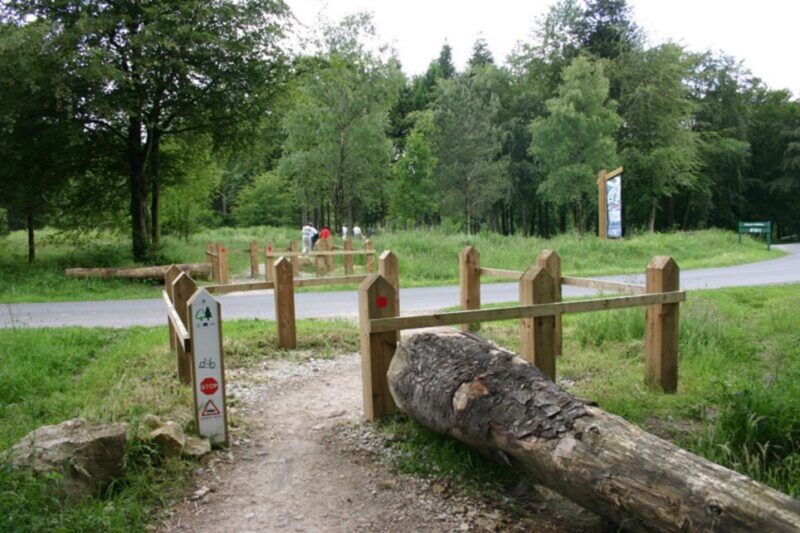 Cycle route crossing forest road
Chicanes encourage cyclists to stop where the trails cross vehicle roads.
Signs also indicate the quickest way back to the visitor centre, in case of emergency.
Cycle route crossing forest road
Chicanes encourage cyclists to stop where the trails cross vehicle roads.
Signs also indicate the quickest way back to the visitor centre, in case of emergency.
 Treetop Challenge course
Go Ape is a high wire forest adventure course of rope bridges, tarzan swings and zip slides up to 40 feet up in the trees. It takes between two and three hours to complete it.
Treetop Challenge course
Go Ape is a high wire forest adventure course of rope bridges, tarzan swings and zip slides up to 40 feet up in the trees. It takes between two and three hours to complete it.
 Platforms and ladder
The structures are designed to allow trees to grow unrestricted. Build materials are selected to blend into the natural scenery.
The course is closed if bad weather (lightning, high winds, snow or ice) creates unacceptable risk levels.
Platforms and ladder
The structures are designed to allow trees to grow unrestricted. Build materials are selected to blend into the natural scenery.
The course is closed if bad weather (lightning, high winds, snow or ice) creates unacceptable risk levels.
 User self reliance
An element of risk is designed into the activity. This follows the Go Ape philosophy that exposure to risk in reasonably controlled circumstances is necessary for people to learn how to safely assess and deal with risks that present themselves in life.
Participants are unaccompanied and take responsibility for attaching themselves to the safety system.
The minimum age is 10 years and participants must also be over 1.4 metres (4 feet 7 inches) tall.
Under 18 year olds have to be accompanied by a participating adult.
[post_title] => Dalby Forest
[post_excerpt] => This case study explores how leisure activities can be safely accommodated within a working forest.
[post_status] => publish
[comment_status] => closed
[ping_status] => closed
[post_password] =>
[post_name] => dalby-forest-north-york-moors
[to_ping] =>
[pinged] =>
[post_modified] => 2021-08-05 10:41:25
[post_modified_gmt] => 2021-08-05 09:41:25
[post_content_filtered] =>
[post_parent] => 0
[guid] => https://staging.vscg.org/?post_type=case-study&p=829
[menu_order] => 0
[post_type] => case-study
[post_mime_type] =>
[comment_count] => 0
[filter] => raw
)
[1] => WP_Post Object
(
[ID] => 857
[post_author] => 1
[post_date] => 2019-06-06 15:33:14
[post_date_gmt] => 2019-06-06 14:33:14
[post_content] => This case-study illustrates how levels of risk can be reduced to a more acceptable level. It is perhaps of particular interest to managers faced with activities on their land that, pragmatically, it would be impossible to eradicate even if it were desirable to do so.
Kingsford Forest Park lies about two miles north of Kidderminster and is within easy reach of the Black Country. It is managed by Worcestershire County Council’s Countryside Service from Waseley Hills Country Park some ten miles away. Over the past two or three years it has increasingly been used by downhill mountain-bikers who had developed their own unofficial courses. Most of the courses crossed a busy path causing a number of problems including:
User self reliance
An element of risk is designed into the activity. This follows the Go Ape philosophy that exposure to risk in reasonably controlled circumstances is necessary for people to learn how to safely assess and deal with risks that present themselves in life.
Participants are unaccompanied and take responsibility for attaching themselves to the safety system.
The minimum age is 10 years and participants must also be over 1.4 metres (4 feet 7 inches) tall.
Under 18 year olds have to be accompanied by a participating adult.
[post_title] => Dalby Forest
[post_excerpt] => This case study explores how leisure activities can be safely accommodated within a working forest.
[post_status] => publish
[comment_status] => closed
[ping_status] => closed
[post_password] =>
[post_name] => dalby-forest-north-york-moors
[to_ping] =>
[pinged] =>
[post_modified] => 2021-08-05 10:41:25
[post_modified_gmt] => 2021-08-05 09:41:25
[post_content_filtered] =>
[post_parent] => 0
[guid] => https://staging.vscg.org/?post_type=case-study&p=829
[menu_order] => 0
[post_type] => case-study
[post_mime_type] =>
[comment_count] => 0
[filter] => raw
)
[1] => WP_Post Object
(
[ID] => 857
[post_author] => 1
[post_date] => 2019-06-06 15:33:14
[post_date_gmt] => 2019-06-06 14:33:14
[post_content] => This case-study illustrates how levels of risk can be reduced to a more acceptable level. It is perhaps of particular interest to managers faced with activities on their land that, pragmatically, it would be impossible to eradicate even if it were desirable to do so.
Kingsford Forest Park lies about two miles north of Kidderminster and is within easy reach of the Black Country. It is managed by Worcestershire County Council’s Countryside Service from Waseley Hills Country Park some ten miles away. Over the past two or three years it has increasingly been used by downhill mountain-bikers who had developed their own unofficial courses. Most of the courses crossed a busy path causing a number of problems including:
- Risks (perceived and genuine) to other visitors including horse-riders and walkers often with young children
- Risks to less experienced riders using the courses unsupervised
- Risks to even the more experienced riders
- Litter and a general air of poor management
- Trees were felled across the courses making them impossible to use
- Signs were posted explaining why the action had been taken and asking participants to make contact with the Countryside Service
- One official route has been agreed and way-marked in such a way that an inexperienced rider could not inadvertently stray onto it.
- No jumps are permitted to be constructed without the written consent of the Countryside Service
- The Countryside Service has provided bins and the mountain-bikers ensure that no litter is left in the area
- The mountain-bikers have been encouraged to focus activities on agreed days and to provide marshals at the point where the course crosses another path
- A code of conduct has been agreed to improve relationships with other visitors
- All participants are encouraged to wear helmets and to maintain their bikes properly
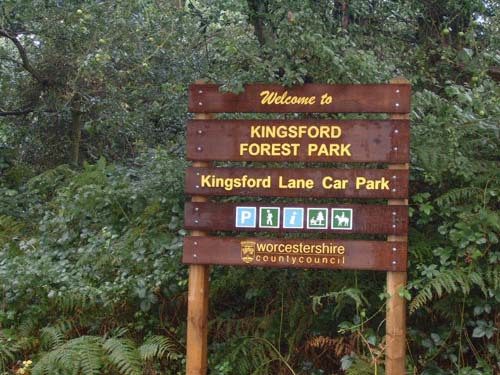
Kingsford Forest Park
Kingsford Forest Park lies about two miles north of Kidderminster and is within easy reach of the Black Country. It is managed by Worcestershire County Council’s Countryside Service from Waseley Hills Country Park some ten miles away.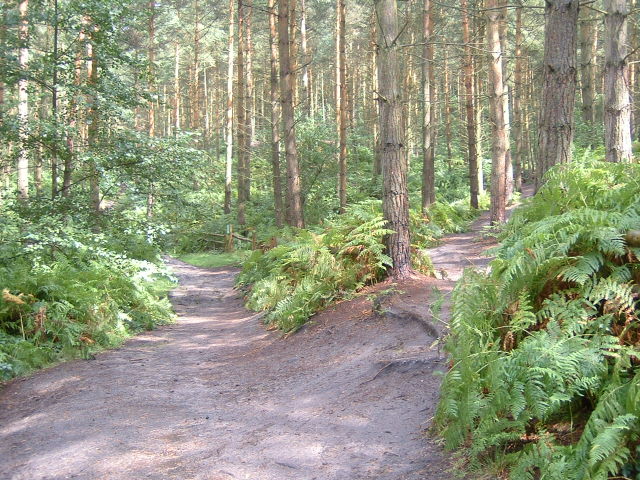
Bike Track
Kingsford Forest Park has increasingly been used by downhill mountain-bikers who developed their own unofficial courses. Here the bike track (coming down from the right) crosses another path used by horse riders. Structures such as berms are maintained at crossing points to slow the bikers down.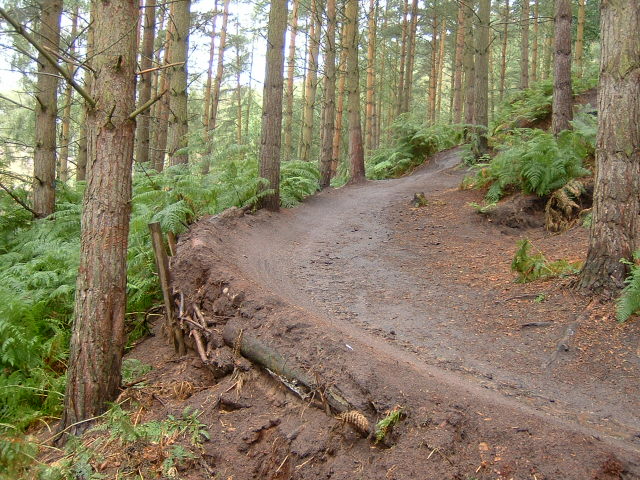
Logs
Logs were used to build up and stabilise bends on the course.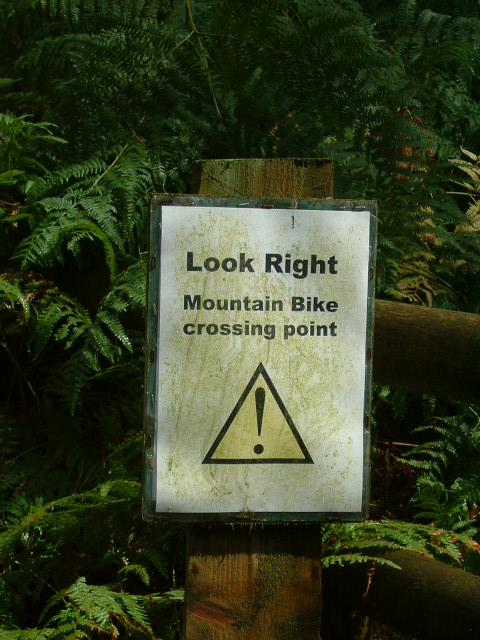
Horse Route
Signs were put up where paths crossed causing potential conflict with other users.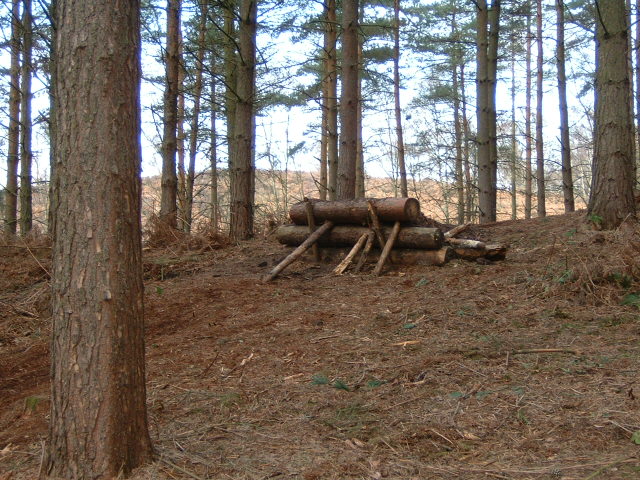
Moutain Bike Jump
No jumps are permitted to be constructed without the written consent of the Countryside Service. There is a regular group of bikers that carry out work to jumps and different courses within the boundaries. They are very good at monitoring the courses, clearing litter and removing any unsafe structures.Download Case Study
Word Document | Adobe PDF This case study was written by Andy Maginnis, Worcestershire County Council and was published in September 2003 This website entry was last updated on 5 November, 2015 [post_title] => Kingsford Forest Park, Kidderminster [post_excerpt] => A very early (2003) example of the application of VSG principles to manage mountain bike risks. [post_status] => publish [comment_status] => closed [ping_status] => closed [post_password] => [post_name] => kingsford-forest-park-kidderminster [to_ping] => [pinged] => [post_modified] => 2021-01-14 15:55:28 [post_modified_gmt] => 2021-01-14 15:55:28 [post_content_filtered] => [post_parent] => 0 [guid] => https://staging.vscg.org/?post_type=case-study&p=857 [menu_order] => 0 [post_type] => case-study [post_mime_type] => [comment_count] => 0 [filter] => raw ) ) [block_anchor] => ) ) 1Become a member of the Visitor Safety Group
Why subscribe?
The content on this page is only available to VSG Members and Subscribers.
Join or subscribe today for:
- Expert advice and support from a friendly and welcoming network
- Unlimited access to full guidance on all safety topics
- Free PDFs of all our publications
- Free attendance at workshops and webinars
Already a member? Log in